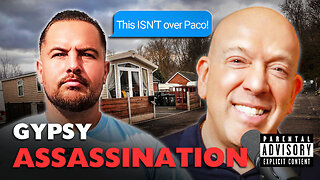Premium Only Content

LAS VEGAS MARKET TRENDS AND UPDATE
We have owned and invested in property in the Las Vegas market for over 12 years(we did take a long break after the 2008 crisis. I have residency between Las Vegas and California. I think we have a unique understanding of the Las Vegas market. and can help you with your Real Estate needs.
Las Vegas (/lɒsˈveɪɡəs/; Spanish for "The Meadows"), often known simply as Vegas, is the 26th-most populous city in the United States, the most populous city in the state of Nevada, and the county seat of Clark County. The city anchors the Las Vegas Valley metropolitan area and is the largest city within the greater Mojave Desert.[7] Las Vegas is an internationally renowned major resort city, known primarily for its gambling, shopping, fine dining, entertainment, and nightlife. The Las Vegas Valley as a whole serves as the leading financial, commercial, and cultural center for Nevada.
The city bills itself as The Entertainment Capital of the World and is famous for its mega casino-hotels and associated activities. It is a top three destination in the United States for business conventions and a global leader in the hospitality industry, claiming more AAA Five Diamond hotels than any other city in the world.[8][9][10] Today, Las Vegas annually ranks as one of the world's most visited tourist destinations.[11][12] The city's tolerance for numerous forms of adult entertainment earned it the title of "Sin City",[13] and has made Las Vegas a popular setting for literature, films, television programs, and music videos.
Las Vegas was settled in 1905 and officially incorporated in 1911. At the close of the 20th century, it was the most populated North American city founded within that century (a similar distinction was earned by Chicago in the 19th century). Population growth has accelerated since the 1960s, and between 1990 and 2000 the population nearly doubled, increasing by 85.2%. Rapid growth has continued into the 21st century, and according to the United States Census Bureau, the city had 641,903 residents in 2020,[5] with a metropolitan population of 2,227,053.[14]
As with most major metropolitan areas, the name of the primary city ("Las Vegas" in this case) is often used to describe areas beyond official city limits. In the case of Las Vegas, this especially applies to the areas on and near the Las Vegas Strip, which are actually located within the unincorporated communities of Paradise and Winchester.[15][16]
1931 was a pivotal year for Las Vegas. At that time, Nevada legalized casino gambling and reduced residency requirements for divorce to six weeks. This year also witnessed the beginning of construction on nearby Hoover Dam. The influx of construction workers and their families helped Las Vegas avoid economic calamity during the Great Depression. The construction work was completed in 1935.
In late 1941, Las Vegas Army Airfield was established. Renamed Nellis Air Force Base in 1950, it is now home to the United States Air Force Thunderbirds aerobatic team.[24]
Following World War II, lavishly decorated hotels, gambling casinos, and big-name entertainment became synonymous with Las Vegas.
This view of downtown Las Vegas shows a mushroom cloud in the background. Scenes such as this were typical during the 1950s. From 1951 to 1962, the government conducted 100 atmospheric tests at the nearby Nevada Test Site.[25]
In 1951, nuclear weapons testing began at the Nevada Test Site, 65 miles (105 km) northwest of Las Vegas. During this time, the city was nicknamed the "Atomic City". Residents and visitors were able to witness the mushroom clouds (and were exposed to the fallout) until 1963 when the Partial Nuclear Test Ban Treaty required that nuclear tests be moved underground.[25]
In 1955, the Moulin Rouge Hotel opened and became the first racially integrated casino hotel in Las Vegas.
The iconic "Welcome to Las Vegas" sign, which has never been located within municipal limits, was created in 1959 by Betty Willis.[26]
Las Vegas is situated within Clark County, in a basin on the floor of the Mojave Desert,[28] and is surrounded by mountain ranges on all sides. Much of the landscape is rocky and arid, with desert vegetation and wildlife. It can be subjected to torrential flash floods, although much has been done to mitigate the effects of flash floods through improved drainage systems.
Las Vegas has a subtropical hot desert climate (Köppen climate classification: BWh), typical of the Mojave Desert in which it lies. This climate is typified by long, extremely hot summers; warm transitional seasons; and short winters with mild days and cool nights. There is abundant sunshine throughout the year, with an average of 310 sunny days and bright sunshine during 86% of all daylight hours. Las Vegas is among the sunniest, driest, and least humid locations in North America, with exceptionally low dew points and humidity that sometimes remain below 10%.
XRXVCH4NAJUNHCD8
-
 1:14:04
1:14:04
NONCONFORMING-CONFORMIST
9 months agoYOU HAVE TO PAY A LOT AND IN SO MANY WAYS TO TAKE PART IN THIS WORLD
482 -
 1:34:30
1:34:30
The Criminal Connection Podcast
5 days ago $0.73 earnedEL PACO: Gypsy Family Wars, Bare Knuckle Boxing, Assassinations and Spirits!
8.75K -
 51:43
51:43
Brewzle
1 day agoI Found Some AWESOME Stores Bourbon Hunting in Des Moines, IA
11.3K1 -
 1:16:54
1:16:54
Kyle Rittenhouse Presents: Tactically Inappropriate
21 hours ago $0.80 earnedReplacing Matt Gaetz Pt. 2
4.53K1 -
 16:08
16:08
inspirePlay
22 hours ago $0.28 earnedCan You Sniff Out the Golf Imposters Before They Wreck the Score?
4.43K2 -
 22:57
22:57
RTT: Guns & Gear
19 hours ago $1.51 earnedPSA Dagger vs. Bear Creek Arsenal BC-102 | The Better Pistol For The Poors
17.6K9 -
 8:28
8:28
MichaelBisping
5 hours agoBISPING: "Islam WILL RETIRE after UFC 311!?" | Makhachev Wants Belal or Shavkat at WELTERWEIGHT
9.3K3 -
 1:13:55
1:13:55
Eye of the STORM
4 months agoEye of the STORM Podcast S2 E3 08/19/24 with Sam Anthony
6.74K1 -
 1:04:22
1:04:22
PMG
2 hours ago $0.12 earned"Your Marriage Can Be Saved with Art Thomas"
5.1K1 -
 59:14
59:14
Tactical Advisor
5 hours agoNew Gun Build / Fires update | Vault Room Live Stream 013
38.7K8